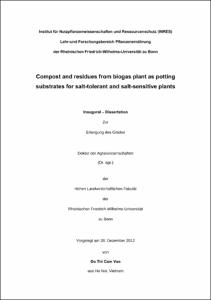Compost and residues from biogas plant as potting substrates for salt-tolerant and salt-sensitive plants

Compost and residues from biogas plant as potting substrates for salt-tolerant and salt-sensitive plants

| dc.contributor.advisor | Scherer, Heinrich Wilhelm | |
| dc.contributor.author | Do, Thi Cam Van | |
| dc.date.accessioned | 2020-04-18T11:56:07Z | |
| dc.date.available | 2020-04-18T11:56:07Z | |
| dc.date.issued | 10.01.2013 | |
| dc.identifier.uri | https://hdl.handle.net/20.500.11811/5529 | |
| dc.description.abstract | Compost and residues from biogas plant have been increasingly recognized as potting substrates in horticulture. To investigate the suitability of both materials to grow salt tolerant plants in 2010 a pot experiment was conducted in the greenhouse of INRES-Plant nutrition, University of Bonn. Ryegrass (Lolium perenne L.), rape (Brassica napus) and sunflower (Helianthus annuus) were chosen as experimental plants. To reduce the high salt content compost and residues from biogas plant were leached. To improve physical characteristics of raw materials, additives including Perlite, Styromull, Hygromull, Lecaton, Peat, Cocofiber were incorporated into compost or residues from biogas plant with the volumetric ratio of 4:1. Plant growth (DM) and nutrient uptake (N, P, K, Mg, Ca, Na and S) of the experimental plants grown in compost-based or residue-based substrates with and without additives and standard soil as a control were determined. Preliminary results reveal that origin compost and residues from biogas plant without leaching are suitable potting substrates for those plants. For compost leaching may not be recommended while for residues from biogas plant the effect of leaching was not distinct and needs further investigations. The incorporation of additives into the basic materials partially resulted in higher plant dry matter yield and nutrient uptake. However, differences between the additives on both parameters were mainly insignificant. Incorporation of Hygromull or Peat, especially into residues from biogas plant favored plant growth and enhanced total nutrient uptake. In 2011, pot experiments were continued with the salt-sensitive ornamental plants, Pelargonium (Pelargonium zonale Toro) and Salvia (Salvia splendens). Two separate experiments were carried out for the mixtures of compost and additives (SPS standard soil type 73 based on Peat, Hygromull or Cocofiber) with different volumetric ratios (4:1, 1:1, 1:4) and the mixtures of Peat incorporated with small proportions of compost and additives (Styromull or Perlite). The results show that the large percentage (> 50% by volume) of compost in the substrate had negative effects on plant growth and nutrient uptake (N, P, K, Mg and Na) because of its high salt content in compost-based substrates. However, both yield formation and nutrient uptake of the studied plants when grown in peat-based substrates significantly increased comparing to those of compost-based substrates and almost gained the level of the control. Especially, the growth of Salvia was significantly improved. Consequently, compost-based media (with more than 50% of compost) may not be recommended for salt sensitive ornamental plants, while less than 25% volume of compost incorporated with Peat creates favorable peat-based substrates which reasonably enhanced growth of Pelargonium and Salvia. Investigating antibiotic uptake by cabbage (Brassica oleracea var. capitata f. abba) from the manure-amended soils containing high and low carbon content spiked with the two antibiotics Chlortetracycline and Sulfamethazine was targeted as the third objective. The input concentrations of the studied antibiotics were 100, 200 and 400 µg/kg regarded to their present concentration range in Chinese top soils. The antibiotics in plant materials were analyzed by HPLC-MS after extraction. The results reveal that the presence of available high carbon content in the soil increased crop yield of cabbage. However antibiotics were not detected in the cabbage materials according to the antibiotic employment with the initial studied concentrations. It may be concluded that with the small amounts of antibiotics applied to the soils, there is no risk of uptake of antibiotics by plants. | en |
| dc.language.iso | eng | |
| dc.rights | In Copyright | |
| dc.rights.uri | http://rightsstatements.org/vocab/InC/1.0/ | |
| dc.subject.ddc | 580 Pflanzen (Botanik) | |
| dc.title | Compost and residues from biogas plant as potting substrates for salt-tolerant and salt-sensitive plants | |
| dc.type | Dissertation oder Habilitation | |
| dc.publisher.name | Universitäts- und Landesbibliothek Bonn | |
| dc.publisher.location | Bonn | |
| dc.rights.accessRights | openAccess | |
| dc.identifier.urn | https://nbn-resolving.org/urn:nbn:de:hbz:5n-30760 | |
| ulbbn.pubtype | Erstveröffentlichung | |
| ulbbnediss.affiliation.name | Rheinische Friedrich-Wilhelms-Universität Bonn | |
| ulbbnediss.affiliation.location | Bonn | |
| ulbbnediss.thesis.level | Dissertation | |
| ulbbnediss.dissID | 3076 | |
| ulbbnediss.date.accepted | 20.12.2012 | |
| ulbbnediss.fakultaet | Landwirtschaftliche Fakultät | |
| dc.contributor.coReferee | Clemens, Joachim |
Files in this item
This item appears in the following Collection(s)
-
E-Dissertationen (1118)




